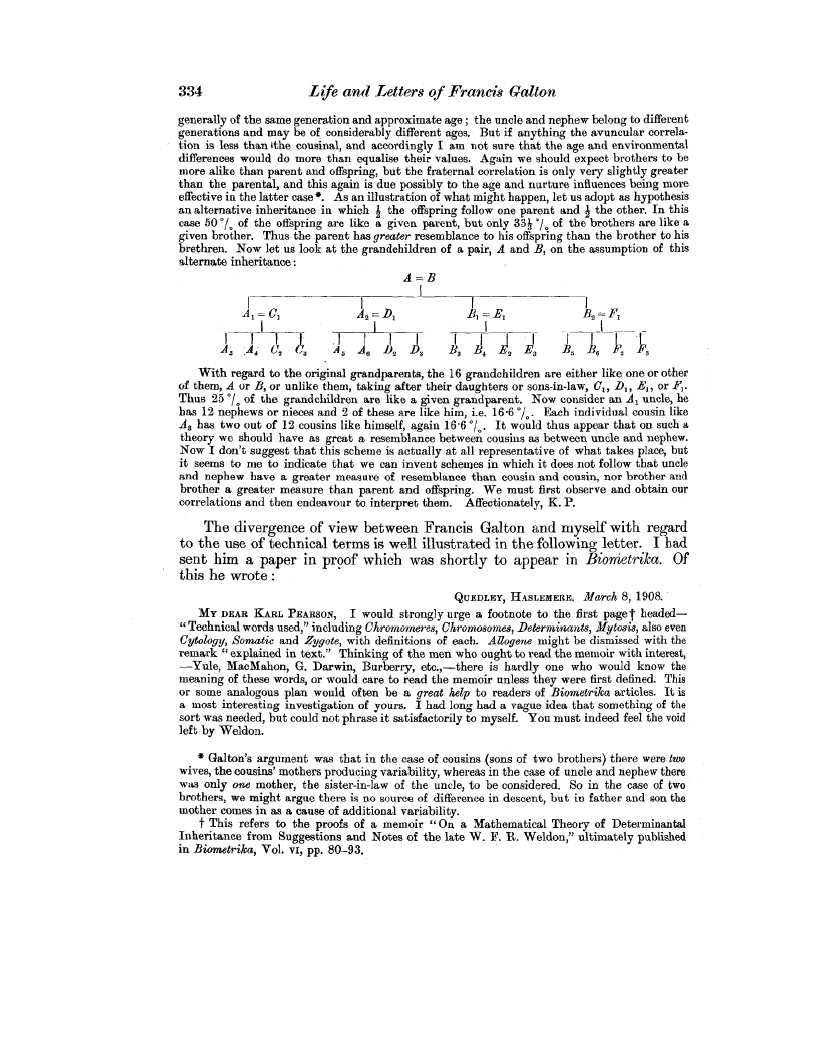| ||||||

OCR Rendition - approximate
334 Life and Letters of Francis Galton generally of the same generation and approximate age ; the uncle and nephew belong to different generations and may be of considerably different ages. But if anything the avuncular correlation is less than +tbe cousinal, and accordingly I am not sure that the age and environmental differences would do more than equalise their values. Again we should expect brothers to be more alike than parent and offspring, but the fraternal correlation is only very slightly greater than the parental, and this again is due possibly to the age and nurture influences being more effective in the latter case*. As an illustration of what might happen, let us adopt as hypothesis an alternative inheritance in which } the offspring follow one parent and j the other. In this case 50'/. of the offspring are like a given parent, but only 33J °/° of the brothers are like a given brother. Thus the parent has greater resemblance to his offspring than the brother to his brethren. Now let us look at the grandchildren of a pair, A and B, on the assumption of this alternate inheritance A=B I I I I I A, C, A2 D, B, E, B2 Fl I~! 1 t 1 1 I I I I I I I I I I A3 A4 C2 3 A5 A6 D2 D3 B3 B4 B2 E3 B5 B6 F2 F3 With regard to the original grandparents, the 16 grandchildren are either like one or other of them, A or B, or unlike them, taking after their daughters or sons-in-law, C1, D„ E„ or F,. Thus 25 °/° of the grandchildren are like a given grandparent. Now consider an Al uncle, he has 12 nephews or nieces and 2 of these are like him, i.e. 16.6 °/°. Each individual cousin like A3 has two out of 12 cousins like himself, again 16.6 °/°. It would thus appear that on such a theory we should have as great a resemblance between cousins as between uncle and nephew. Now I don't suggest that this scheme is actually at all representative of what takes place, but it seems to me to indicate that we can invent schemes in which it does not follow that uncle and nephew have a greater measure of resemblance than cousin and cousin, nor brother and brother a greater measure than parent and offspring. We must first observe and obtain our correlations and then endeavour to interpret them. Affectionately, K. P. The divergence of view between Francis Galton and myself with regard to the use of technical terms is well illustrated in the following letter. I had sent him a paper in proof which was shortly to appear in Bionietrika. Of this he wrote QUEDLEY, HASLEMERE. March 8, 1908. MY DEAR KARL PEARSON, I would strongly urge a footnote to the first page' headed Technical words used," including Chromomeres, Chromosomes, Determinants, Mycosis, also even Cytology, Somatic and Zygote, with definitions of each. Allogene might be dismissed with the remark "explained in text." Thinking of the men who ought to read the memoir with interest, -Yule, MacMahon, G. Darwin, Burberry, etc.,-there is hardly one who would know the meaning of these words, or would care to read the memoir unless they were first defined. This or some analogous plan would often be a great help to readers of Biometrika articles. It is a most interesting investigation of yours. I had long had a vague idea that something of the sort was needed, but could not phrase it satisfactorily to myself. You must indeed feel the void left by Weldon. * Galton's argument was that in the case of cousins (sons of two brothers) there were two wives, the cousins' mothers producing variability, whereas in the case of uncle and nephew there was only one mother, the sister-in-law of the uncle, to be considered. So in the case of two brothers, we might argue there is no source of difference in descent, but in father and son the mother comes in as a cause of additional variability. t This refers to the proofs of a memoir " On a Mathematical Theory of Determinantal Inheritance from Suggestions and Notes of the late W. F. R. Weldon," ultimately published in Biometrika, Vol. vi, pp. 80-93.
|